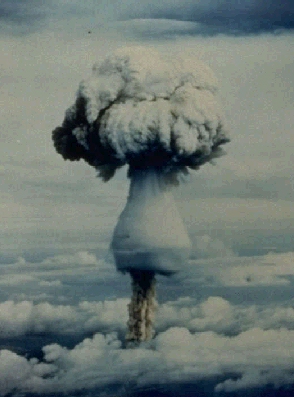In 1951 the United States conducted its 5th Nuclear test series, code named Operation Greenhouse. As with any scientific test, the United States began experimenting with the concept of thermonuclear weapons, more commonly known as Hydrogen Bombs. This series of tests took place at the newly established Pacific Proving Ground. The test series would encompass four detonations, each mounted on steel towers to simulate areal detonations.
The four tests of Greenhouse represented a new aggressive design of nuclear weapons, looking to take the ultimate weapon one step further. Traditional nuclear weapons were very large in size, weight and required a high amount of fissile material. The ideas behind Greenhouse were to reduce each of the above traditional requirements to build more powerful weapons with less material, making them more operational.
A year and a half before Operation Greenhouse, on August 29 1949, the Soviet Union detonated RDS-1, nicknamed "Joe-1." The test yielded 22 Kilotons, and surprised the world. The United States only detected radioactive fission products days after the blast, and traced them back to the USSR. On September 23rd 1949, President Harry Truman announced to the world that the Soviet Union had successfully detonated an atomic bomb. This statement is considered by many to be the official beginning of the Cold War, as both the United States and the Soviet Union began working on the first Hydrogen Bomb.
The first two tests of Greenhouse, were of traditional nuclear weapons with minor adjustments to the firing mechanism. "Dog" tested on April 8th 1951 yielded 81 kilotons, and "Easy" tested on April 21st 1951 yielded 47 kilotons. It was the last two tests of this series that took major steps forward to designing a Hydrogen Bomb.
"George" was tested on the 9th of May 1951 and was the first recorded thermonuclear experiment conducted by the United States. "George" was actually considered a thermonuclear burn, due to the addition of a small amount of heavy isotopes of liquid hydrogen (deuterium and tritium) that were injected into the core of the bomb. "George" acted more liked a boosted nuclear bomb than a Hydrogen bomb. The findings from "George" validated the theories that brought about the ideas of a thermonuclear weapon, and would be used when designing "Ivy Mike." "George" yielded 225 kilotons.
 |
| "George" Test shot mushroom cloud. nuclearweaponarchive.org |
The final test of Operation Greenhouse was "Item." Like "George," "Item" was a test of a boosted fission weapon. "Item" was injected with deuterium-tritium gas into the uranium core.The heat of the gas produced a thermonuclear fusion reaction, but not enough to be fully considered a fusion bomb. The planning behind "George" and "Item" was from the great mind of Dr. Edward Teller in 1947. Teller has designed the idea of a booster to create a more powerful reaction, causing a larger detonation. While much smaller than "George", "Item" yielded 45.5 kilotons, but proved effective in pumping the booster gas into the weapon before detonation. The test was primarily a test of the nuclear principles involved and to gain valuable research data. It was never considered a design for weaponizing a device.
The nuclear discoveries that Operation Greenhouse provided helped the United States design and successfully test "Ivy Mike" in November 1952. Thermonuclear Weapons would change the face of the Cold War, as would bigger and larger nuclear bombs.
Remembering History - Operation Greenhouse
No comments:
Post a Comment